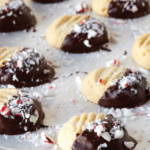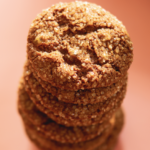 With the High Holidays coming up, Judy Bart Kancigor, author of Cooking Jewish, shares some of her favorite holiday memories and recipes.
With the High Holidays coming up, Judy Bart Kancigor, author of Cooking Jewish, shares some of her favorite holiday memories and recipes.
To read an excerpt from Cooking Jewish, click here or scroll to the bottom of this post.
When I was growing up, my large, boisterous family would gather in my grandparents’ tiny apartment in Belle Harbor, New York, for the festive Rosh Hashanah meal. Papa Harry, a carpenter who had emigrated from Russia in 1906, would extend the dining table with boards reaching practically to the walls. The arrival of the aunties with their foil-covered dishes signaled the beginning of the holiday feast, a menu that seldom varied:
For the forshpeis (appetizer) Aunt Estelle’s homemade, lovingly shaped gefilte fish served with Uncle Lou’s horseradish, hand-grated on the back porch to keep out the fumes;
Aunt Irene’s golden chicken soup and ethereal matzoh balls, followed by Mama Hinda’s roast chicken and brisket with oven-browned potatoes and Aunt Sally’s tsimmes (sweet carrot stew).
The centerpiece of the table was Mama Hinda’s grand spiral challah, round for Rosh Hashanah, the Jewish New Year, a symbol of the endless cycle of life. Only for this holiday would she add raisins, a sweet embellishment to enjoy a sweet New Year.
Sweet notes echoed from the beginning of the meal, as all assembled dipped apples in honey, to the dessert platters wedged onto Mama’s groaning sideboard: Aunt Irene’s dark, dense honey cake, Aunt Estelle’s mile-high sponge cake, Aunt Hilda’s chocolate chip mandelbrot (twice-baked cookies), and Aunt Sally’s apple strudel and taiglach, crisp cookie balls slowly simmered in honey.
Over at the children’s table, a gaggle of cousins, raised practically as siblings, chattered, spilled soup, shouted, squabbled, hiccupped with laughter, fought over drumsticks, dropped crumbs, clamored for seconds, and ran around, as far as one could run in such tight quarters, until a withering look from one of the aunties brought a temporary attitude adjustment, and then it was back to the merriment.
Or so I’m told.
We were never there!
My parents, Lillian and Jan Bart, were singers, and as I recall the Jewish holidays of my childhood, no idyllic scene of family gatherings comes to mind. Dad was also a part-time cantor, and we spent Rosh Hashanah at New York’s Riverside Plaza Hotel where Dad, along with a rented rabbi, conducted his magnificent services, complete with choir (including my mom’s glorious contralto) for a congregation that had lost its building in a fire and had never rebuilt.
We took our holiday meal, not with the family, but at places like Jack Silverman’s Old Romanian restaurant on Allen Street on the Lower East Side, where Dad performed club dates throughout the year, joining the ranks of such legendaries as Julius La Rosa, Joey Adams and Myron Cohen.
By my late teens, my parents’ holiday gig had moved to the Windsor Hotel in the “Borscht Belt,” New York’s Catskill Mountains, where “the holidays” meant a fun-packed vacation, a land-cruise with an endless buffet.
With my dad’s death, at age 52, in August of 1971 – and our move just a few weeks later to California, where my brother and his family had already settled – the party came to a screeching halt.
Rosh Hashanah 1971 is a blurred memory. Mom had come with us, and for the first time, instead of sharing the holiday meal with hundreds of rollicking vacationers, we set a table for eight in our Tustin apartment.
With no memory bank of our own holiday recipes and 3,000 miles away from the family, Mom and I had to create our own traditions. Sure, the aunts sent us their recipes. Brisket and chicken were no-brainers, but we took one look at the gefilte fish and headed for the Manischewitz. Ditto the horseradish. (In later years the food processor made fast work of both!) A round challah we found at Poul’s Bakery. Our mile-high sponge cake climbed a few inches and collapsed in defeat. And strudel and taiglach? You’ve got to be kidding!
But Aunt Irene’s chicken soup beckoned. Maybe it was the tears of grief, but Mom’s first attempt comforted, nurtured, soothed and succored – Canfield and Hansen are right: Chicken soup truly is a brew “for the soul.”
As the years passed, Mom’s soup morphed into a four-day project. You see, my mother adheres to the “if some is good, more is better” school of cooking. Her secret? The whole produce market goes into that pot…or should I say pots! “You’re messing up the kitchen anyway,” she taught me, “so you might as well make lots and freeze some for later. You never know when someone might catch a cold.”
Mom dishes out wisdom as she ladles her soup, teaching me more in the process than how to clean a kosher chicken. This is a woman who never complains (“What do I have to complain about? I have the best family in the world!”), who doesn’t even own an aspirin (“But I don’t have a headache!”), who accepts with grace all of life’s challenges (“I may be alone, but I’m never lonely.”) More than a course, Mom’s soup is our link to holidays and celebrations past – a memory in every spoonful.





1 Comment
Lisa
May 29, 2010 at 1:47 pmI took Jewish Cooking out of the library and enjoyed it so much……I feel like I’ve met your whole
family! I made the black bottom cupcakes and they were a big hit; my father in law loves chocolate and cheesecake. I have a whole list of other recipes from the book that I am anxious to try. I commend you for taking on such a huge project!